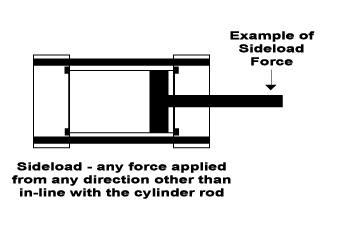Sideloading, as it pertains to air cylinders, is a force applied tangentially to the rod or rod-end tooling. This page provides a better understanding of sideloading, and provides some solutions should an application be creating this cylinder binding or cylinder damaging issue.
Typically, air cylinders are linear devices. They are designed to transmit force down the axis of the piston and piston rod.
However, In order to use the air cylinder, it is necessary to attach some sort of tooling to the end of the rod. It is often the attachment of this tooling to the cylinder rod end that is the source of the cylinder rod sideloading.
As a typical double-acting air cylinder operates, compressed air alternately extends and then retracts the rod, moving the piston inside the air cylinder from end to end inside the barrel.

When the cylinder is in a retracted position – with minimal extension – any tangential force on the rod tip or rod end tooling, can be more easily absorbed by:
- the rod bearing which is what the rod passes through as it exits the rod end cap of the cylinder
- and then by the cylinder piston itself
As pressure is applied sideways on the end of the rod that is retracted, the piston is supported by the inner surface of the air cylinder barrel. The distance between the two bearing points, the rod bearing and the piston itself ameliorates the side loading, enabling the rod to withstand the side load.
Sideloading of the cylinder rod is a very common cause of air cylinder failure. As the cylinder rod strokes, sideways pressure on the rod end or rod tooling wears away at the rod end bearing, creating an air leak at the rod seals. While a maintenance issue, rod end bearing seals are relatively easy to replace. The bearing itself, not so much!
As the bearing seals wear, eventually metatl-to-metal contact occurs, causing scoring of the cylinder rod. This imparts an abrasive finish to the rod surface that quickly further damages rod seals. Now there is a scored cylinder rod, bearing and bearing seals to replace.
If enough sideload is applied to the tooling, it can be enough added load to overcome the ability of the compressed air to move the piston inside the cylinder barrel, and as a result, the piston rod and tooling movement is halted.
Resolving Cylinder Sideloading
Where there is a cylinder application where the rod tip or rod-end tooling will see tangential force, there are things you can do eliminate the sideloading from damaging the cylinder bearing or stopping the cylinder rod movement.
An air cylinder with longer-than-standard rod bearings will provide resistance to side loading.
Order a cylinder built with a stop collar installed inside the cylinder barrel. The stop collar ensures that the piston cannot reach the rod end of the cylinder, effectively increasing the bearing area to resist the effects of sideloading.
Another option is to have the cylinder load guided and supported in such a fashion that sideloading is absorbed by the guiding mechanism, and any force from the side is not applied to the cylinder rod at all.
An alignment coupler is a device that connects the end of the rod to the tooling, and can itself be another method of dealing with side load. The alignment coupler self-adjusts to reduce side load as the rod cycles.
Clevis mounts on the rod end connecting to a mating clevis in the tooling will allow some movement of the tooling without side loading the cylinder rod.
Regardless of the method you use to eliminate cylinder rod side loading, failure to do something will mean a much shortened life cycle for any air cylinder, and that means machine down time to replace or repair the air cylinder.
New comment? New question? Please add it here along with photos to help others help you with your compressor and equipment problem!
